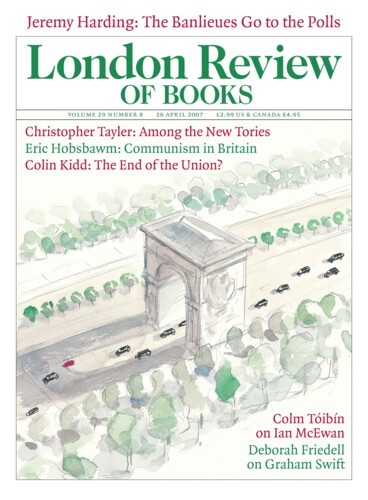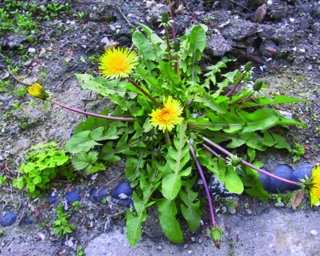Our hedge has gone. The new railings are up. Weeds have begun to cover the bare ground. A dandelion is already flowering. Its seeds will soon appear and be carried off by the wind. Very probably some will find bare earth and germinate. They will not be popular. ‘Not easy to eradicate, regrowth occurs from root fragments,’ the Pest and Weed Expert says.
Weeds follow the spade and the plough and flourish under open skies on broken soil. Oliver Rackham, in his History of the Countryside, says that many weeds ‘could not survive in the wild: they cannot withstand shade and have little power of competition’. They are, in the most general sense, unwanted plants, an uncultivated horde that invades the places we make and keep ready for them – meadows, road verges, cornfields and gardens. We attack them with forks, mattocks and chemicals and a few are driven to extinction. Most re-emerge to sucker or seed about. When land is uncultivated they quickly take it over, as the fields ‘set aside’ under European directives show, but ultimately their reign must be short. If we leave things to take their course even blackberry and bindweed will eventually be overtopped. Weeds have only a passing hegemony and must expect a modest future role in the woodland, heath, savannah, steppe, desert, maquis, bog; or whatever other assemblage – existing or identified by botanists from the evidence of pollen preserved in the layered sediments of ponds and lakes – they are native to. Rampant weeds will often have to adapt to a shadier existence (there are brambles under woodland trees, but they do not flourish there) or find niches created by landslips, browsing animals or fire.
Writers have always found hard things to say about them. King Lear is found
Crown’d with rank fumiter and furrow weeds,
With hardocks, hemlock, nettles, cuckoo flow’rs,
Darnel, and all the idle weeds that grow
In our sustaining corn.
Darnel is a grass. The ‘tares’ of the parable, sown by an enemy among the wheat, are vetch; another furrow weed is a very pretty member of the pea family. Fitzherbert’s Book of Husbandry of 1523 explains the harm it does: ‘Tare is the worst weed … it will grow as high as the corn, and with the weight thereof, it pulleth the corn flat to the earth.’ But names are a trap; it is said that the biblical ‘tares’ is a mistranslation: they were not vetches at all, but darnel.
Some weeds are more sinister. They don’t just compete for nourishment and light: they parasitise. Witchweed draws sustenance from maize roots and threatens food production in sub-Saharan Africa. It has bright green leaves. Truly dependent parasites, which have no need to metabolise for themselves and therefore no need for chlorophyll, are sickly pale. The stems of dodder twine around the host in thick tangles of cream threads. The flowers of broomrape emerge from the ground in leafless spikes. Parasites, more obvious to the eye than the deadly moulds and fungi which rot potatoes and kill elms, are as close as vegetation comes to the aliens that burst from their hosts in science fiction movies, or, I guess, the weed bred in hell of which the Ghost speaks to Hamlet: if he does not act, he will be duller ‘than the fat weed that roots itself in ease on Lethe wharf’.
‘Dodder’ and ‘broomrape’ sound evil; other names point to simple reasons for loathing or disgust. Alligator-weed, itchgrass, stinking mayweed, mother-of-millions, cruel plant, devil’s fig, devil weed, McConnel’s curse: these were all native to provinces colonised by Europeans in the last couple of centuries. More common even than these on the hit lists of New World departments of agriculture are the familiar garden plants introduced by settlers, some accidentally, many on purpose. Like the settlers themselves they flourish at the expense of the indigenous inhabitants, even threatening to displace them. In Britain introductions as ancient as the sycamore (it may have come in with the Romans) have a weed-like propensity to seed themselves and take the place of trees with longer, better histories.
In temperate lands, colonised in the 18th and 19th centuries, dramatic interactions between native and exotic floras were played out within the span of a human lifetime. In 1921 Herbert Guthrie-Smith published a comprehensive history – human, geological and ecological – of Tutira, a sheep station on the east coast of the North Island of New Zealand. He leased the land, and worked and lived on it from 1882 until his death in 1940. During forty-plus years he observed the comings and goings of all the plants – native and introduced – which held, found or sometimes lost a foothold. (‘Increase in weed species,’ he writes, ‘has been matched by equal losses. A minority only are firmly, permanently anchored on the run.’) During those years 60,000 steep acres, mostly covered in bracken, were gradually transformed into pasture. Guthrie-Smith notes both his hard-won success as a farmer and his more questionable achievements as an agent of change. In Tutira, the farmer, the disinterested naturalist and the conservationist join forces in drawing up a verdict on the blackberry. Sheep, he says, can deal with most things: ‘one plant alone – the blackberry (Rubus fruticosus) – is his master, seducing him to destruction with the bait of its black fruit, openly trailing great runners for his entanglement and finally feeding on his carcase.’ Introduced plants turn up in New Zealand poetry, in the way furrow weeds do in Shakespeare, as images of disorder. New Zealand becomes a country, in Denis Glover’s Sings Harry,
Where all around us ancient ills
Devour like blackberry the hills.
Blackberry can be seen putting out a shoot on the left of the picture on this page. It also reaches over the fence from the untended garden next door. It grabs at you as it makes the leap by way of long shoots that loop away from the parent and root themselves on new ground. And yet the plant is handsome and wonderfully healthy – unspotted and not nibbled by insects (trials in Australia have shown that a blackberry rust fungus can hold it back, though not destroy it entirely). The colour scheme is richly sober (fruit black, stems and leaves dark reds and greens, the flowers pale lavender, pink and white). Leonardo’s drawing of its flowers and fruit catches something of its thrusting, abundant prosperity.
Opportunists ourselves (few plants exist, as we do, in every earthly environment), humans tend to make weeds a scapegoat. The weeds, not the humans who brought them, get the blame for putting habitats at risk. There is, of course, an absolute value in variety, so to remove invaders and preserve natives must be a good thing. Sometimes, though, I can see it from the weed’s point of view. Why should feeble native plants on isolated islands, sheltered for millennia from competition, be coddled, particularly when they are neither beautiful nor useful? On the other hand, one comes to have a particular admiration for robust landscapes that stand up to invasion. In The Nature of Mediterranean Europe by A.T. Grove and Oliver Rackham, it is said that ‘Mediterranean wild vegetation has a mysterious resistance to exotic invasion. Much of California in a similar climate has been overrun by Mediterranean plants, especially annual grasses, but the Mediterranean is not, in general, overrun by Californian plants.’ One admires a flora that fights back.
Gorse covered many of the steep hillsides round Wellington when I was growing up. It would catch fire; great columns of smoke and flame were one of summer’s excitements. Now most of those hillsides have reverted to native bush. Gorse, like blackberry, was a plant of choice for those writers in the 1930s and 1940s who wanted home truths and had no truck with Georgian verses in which the fern and tui had been too easily substituted for the English hawthorn and thrush. Dan Davin, for example, wrote a volume of short stories called The Gorse Blooms Pale. It is just possible that, thanks to resurgent bush and introduced parasites, the erstwhile weed will become a sentimental memory.
Send Letters To:
The Editor
London Review of Books,
28 Little Russell Street
London, WC1A 2HN
letters@lrb.co.uk
Please include name, address, and a telephone number.


